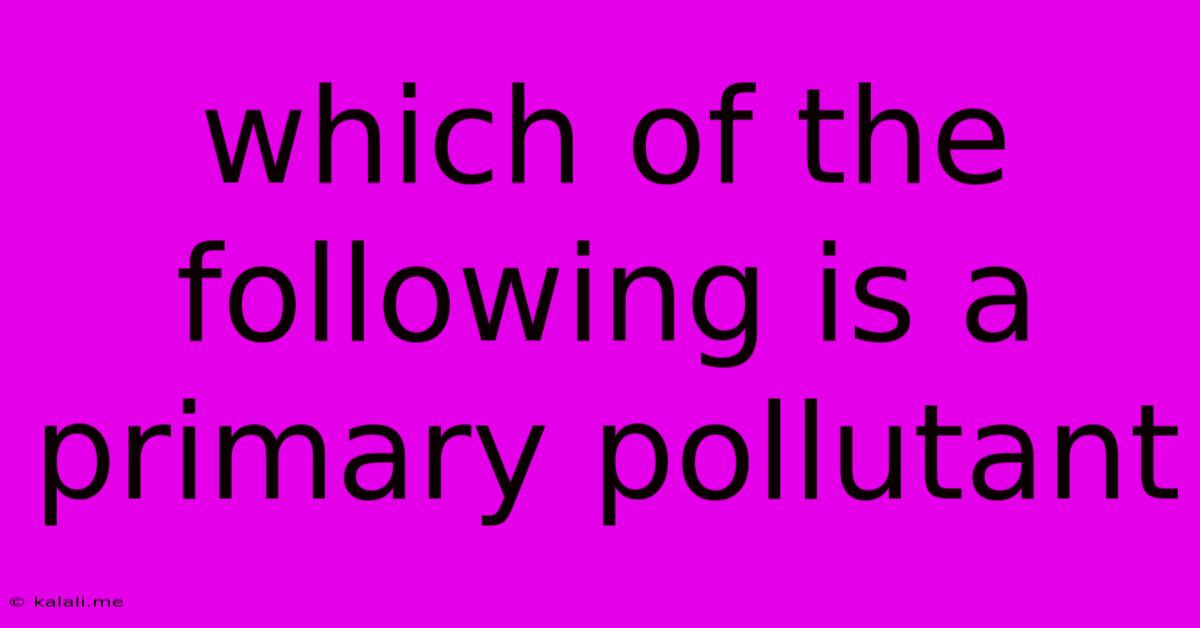Which Of The Following Is A Primary Pollutant
Kalali
Jun 14, 2025 · 3 min read

Table of Contents
Which of the Following is a Primary Pollutant? Understanding Air Pollution Sources
Air pollution is a significant environmental concern, impacting human health and the planet's ecosystems. Understanding the different types of pollutants, particularly the distinction between primary and secondary pollutants, is crucial for effective mitigation strategies. This article will clarify the definition of a primary pollutant and help you identify one from a given list.
What is a Primary Pollutant?
A primary pollutant is a harmful substance emitted directly into the atmosphere from a source. This means it's not formed through chemical reactions in the air, but rather released in its harmful form. Think of it as the "original" pollutant, unlike secondary pollutants which are formed from reactions between primary pollutants and other atmospheric components. Examples often include emissions from vehicles, industrial processes, and natural sources like volcanoes.
Key Characteristics of Primary Pollutants:
- Direct Emission: The defining characteristic; it's released directly into the atmosphere.
- Unchanged Form: It's harmful in the form it's emitted, without undergoing further chemical transformations.
- Various Sources: These pollutants can originate from numerous anthropogenic (human-caused) and natural sources.
Examples of Primary Pollutants:
Several substances fall under this category. Some of the most common include:
- Carbon Monoxide (CO): A colorless, odorless gas, primarily from incomplete combustion of fossil fuels in vehicles and industrial processes. It's highly toxic and reduces oxygen delivery in the blood.
- Sulfur Dioxide (SO₂): A pungent, colorless gas often released during the burning of fossil fuels, particularly coal. It contributes to acid rain and respiratory problems.
- Nitrogen Oxides (NOx): A group of gases including nitrogen dioxide (NO₂) and nitric oxide (NO), formed during high-temperature combustion processes in vehicles and power plants. They contribute to smog formation and respiratory issues.
- Particulate Matter (PM): Tiny solid or liquid particles suspended in the air, including dust, soot, and smoke. Sources include vehicle exhaust, industrial emissions, and construction activities. PM is categorized by size (PM₂.₅ and PM₁₀), with smaller particles posing a greater health risk.
- Volatile Organic Compounds (VOCs): Organic chemicals that easily evaporate at room temperature. Sources include solvents, paints, and gasoline. They contribute to smog formation and can have other adverse health effects.
- Lead (Pb): A heavy metal previously used in gasoline and industrial processes. Though largely phased out, residual lead remains in the environment, posing a significant health risk, especially to children.
Distinguishing Primary from Secondary Pollutants:
It's crucial to differentiate primary pollutants from secondary pollutants. Secondary pollutants are formed when primary pollutants react in the atmosphere. For example, ozone (O₃) is a secondary pollutant formed from the reaction of NOx and VOCs in the presence of sunlight. Acid rain is another example, resulting from the reaction of SO₂ and NOx with water vapor in the atmosphere.
Identifying a Primary Pollutant from a List:
When presented with a list of substances, identifying a primary pollutant requires understanding its source and formation. Look for substances directly emitted into the atmosphere without requiring further chemical reactions. If a substance is formed through atmospheric reactions, it's a secondary pollutant.
In conclusion, understanding the nature of primary pollutants is key to comprehending and addressing air pollution effectively. By recognizing their direct emission and harmful properties, we can better target emission sources and implement appropriate control measures to improve air quality and protect public health.
Latest Posts
Latest Posts
-
Find The Area Of A Circle With Radius 28 Cm
Jun 15, 2025
-
Which Statement Is True About Ftp
Jun 15, 2025
-
How To Find The Largest Fraction
Jun 15, 2025
-
How Many Naturally Occurring Elements Are On Earth
Jun 15, 2025
-
What Is The Most Important Factor In Successful Learning
Jun 15, 2025
Related Post
Thank you for visiting our website which covers about Which Of The Following Is A Primary Pollutant . We hope the information provided has been useful to you. Feel free to contact us if you have any questions or need further assistance. See you next time and don't miss to bookmark.